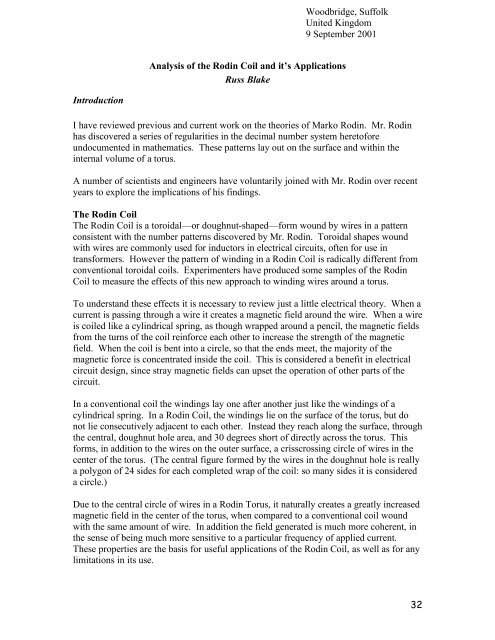Rodin aerodynamics - Free-Energy Devices
Rodin aerodynamics - Free-Energy Devices
Rodin aerodynamics - Free-Energy Devices
Create successful ePaper yourself
Turn your PDF publications into a flip-book with our unique Google optimized e-Paper software.
Introduction<br />
Analysis of the <strong>Rodin</strong> Coil and it’s Applications<br />
Russ Blake<br />
Woodbridge, Suffolk<br />
United Kingdom<br />
9 September 2001<br />
I have reviewed previous and current work on the theories of Marko <strong>Rodin</strong>. Mr. <strong>Rodin</strong><br />
has discovered a series of regularities in the decimal number system heretofore<br />
undocumented in mathematics. These patterns lay out on the surface and within the<br />
internal volume of a torus.<br />
A number of scientists and engineers have voluntarily joined with Mr. <strong>Rodin</strong> over recent<br />
years to explore the implications of his findings.<br />
The <strong>Rodin</strong> Coil<br />
The <strong>Rodin</strong> Coil is a toroidal—or doughnut-shaped—form wound by wires in a pattern<br />
consistent with the number patterns discovered by Mr. <strong>Rodin</strong>. Toroidal shapes wound<br />
with wires are commonly used for inductors in electrical circuits, often for use in<br />
transformers. However the pattern of winding in a <strong>Rodin</strong> Coil is radically different from<br />
conventional toroidal coils. Experimenters have produced some samples of the <strong>Rodin</strong><br />
Coil to measure the effects of this new approach to winding wires around a torus.<br />
To understand these effects it is necessary to review just a little electrical theory. When a<br />
current is passing through a wire it creates a magnetic field around the wire. When a wire<br />
is coiled like a cylindrical spring, as though wrapped around a pencil, the magnetic fields<br />
from the turns of the coil reinforce each other to increase the strength of the magnetic<br />
field. When the coil is bent into a circle, so that the ends meet, the majority of the<br />
magnetic force is concentrated inside the coil. This is considered a benefit in electrical<br />
circuit design, since stray magnetic fields can upset the operation of other parts of the<br />
circuit.<br />
In a conventional coil the windings lay one after another just like the windings of a<br />
cylindrical spring. In a <strong>Rodin</strong> Coil, the windings lie on the surface of the torus, but do<br />
not lie consecutively adjacent to each other. Instead they reach along the surface, through<br />
the central, doughnut hole area, and 30 degrees short of directly across the torus. This<br />
forms, in addition to the wires on the outer surface, a crisscrossing circle of wires in the<br />
center of the torus. (The central figure formed by the wires in the doughnut hole is really<br />
a polygon of 24 sides for each completed wrap of the coil: so many sides it is considered<br />
a circle.)<br />
Due to the central circle of wires in a <strong>Rodin</strong> Torus, it naturally creates a greatly increased<br />
magnetic field in the center of the torus, when compared to a conventional coil wound<br />
with the same amount of wire. In addition the field generated is much more coherent, in<br />
the sense of being much more sensitive to a particular frequency of applied current.<br />
These properties are the basis for useful applications of the <strong>Rodin</strong> Coil, as well as for any<br />
limitations in its use.<br />
32
















